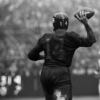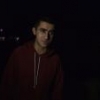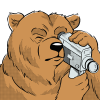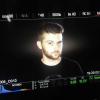Search the Community
Showing results for tags 'Exposure'.
-
Hello all, Planning on doing some time lapse of clouds in the sky, summer afternoon sun, deep blue sky, well formed clouds, moderate telephoto, on Super 16mm color reversal (E 100D, dated 2009) How to measure the light with my Sekonic L-398-A? Measuring incoming light or pointing at the sky to be exposed (white dome) usually leads to underexposure. This light meter lacks spot metering. Any advice or even "rule of thumb" highly appreciated. Cheers, Christian
- 8 replies
-
- exposure
- incidental light
-
(and 3 more)
Tagged with:
-
Hello guys! How are you? I'm shooting an extra scene for my upcoming short, (here are some screenshots): https://www.findspire.com/nabil.mendes/?viewer=7yo4t98o And i've chose the Super8 mm format. It's gonna be an exterior night scene with available light (Paris is pretty well enlightened by Night), and i need some advices. Which camera is the best for my situation between these three: -Canon auto zoom 814 Electronic -Canon 514 XL-S -Nikon Super zoom 8 From my understanding, the Fim stock i need is the Kodak Vision 3 500t, am i right? Will it fit these cameras? Any advice about how to expose a Super8 camera compared to Digital? (i shoot Red mostly) Thanks guys!
- 10 replies
-
- Super8
- Canon 514 XL-S
- (and 5 more)
-
Sometimes when you shoot you want to underexpose a scene. The problem with Dslr is the great amount of noise in the shadows when exposure is not perfect, and other little problems. What's your workflow with this? Thanks to all that answer...
- 7 replies
-
- underexpose
- 5d
-
(and 3 more)
Tagged with:
-
Hi everybody. I have a couple questions on the zebra features of digital cameras. I know it's a feature that helps you seeing which part of the frame correspond to a certain IRE level. What I'd like to know is which level of IRE should the zebra set to. I know it is a customizable feature but I'd like to know generally what should the zebra level set to. Which IRE value corrspond to over exposed to a point of loosing info? And why is there an option to set 2 zebras at the same time?Is it because it's common to set it for a high value of IRE and a low value at the same time in order to check over and under exposure at the same time? Thanks so much in advance for the help!
-
I've been researching the native ISO of RED cameras (primarily the Dragon and MX). What's been confusing isn't the notion of a native ISO, but rather that in the debate between 320 and 800, people are referring to shooting at ISO 800 as underexposing when compared to ISO 320. From one such individual: "At 320 (which may be closer to the sensors "native" sensitivity- or the point where the raw matches the redcolor as far as middle grey) you have much less range in the highlights. By rating 800, you are underexposing the sensor a bit and protecting the highlights." Bear with me as I'm more of a lighting guy, but my question is: how is it that by increasing ISO by 1⅓ stops are you underexposing the sensor? What am I missing? Thanks so much for your help!
-
Hi All, I've noticing on my dailies for recent projects that I am underexposing skin tones. It is mostly intentional as I just find "balanced" shots quite ugly and digital looking - less so on the Dragon and Alexa, most significantly on the C300. I end up putting skin tones around 30% IRE and highlights (say 90% IRE) at about 60% IRE. These projects have all been narratives obviously as I wouldn't be able to get away with this in commercials. I'm wondering if any one else has experienced this with highlights. I'd rather not underexpose as it can make things tough in the grade, but I just find that I prefer everything lower. Khalil
-
Hi. Experienced shooter, new to the C500. Got a couple things going goofy. Help please: Multiple versions of same clip on CF card. Not that important right now. "Proper" exposures IE 70-ish% IRE on caucasian faces result in quite bright images. NOT clipped, but NOT actually overexposed, just overexposed looking. Ditto And the killer is very important: Apparent exposure fluctuations associated with subject movement in the frame. The interviewee raises his hands, waves them around, and bam, the image dims. Like a very fast auto iris or auto ISO kicking in. It's not flicker, but clearly tied to subject movement. Spoke to Canon Cinema support. They're having to research. Thank you!
- 1 reply
-
- exposure
- canon L lenses
-
(and 3 more)
Tagged with:
-
How you go about when you expose for black and white? Does an exposure for black and white differ in term of how you do your exposure and calculation with the light meter, from working in colors? Does the highlights and shadows work the same way as they work shooting in colors? Beside any color temperature consideration, how you work with your exposure when you are shooting black and white, you approach it in a very different way taking more in consideration the reflectances on the subjects? I know for instance if you apply a red filter (such as RED #23) the red object will become lighter: how does the gels and color filters work in black and white? any personal experience on making an exposure for black and white? thanks for answering to my very first post!
- 3 replies
-
- exposure
- black and white
-
(and 3 more)
Tagged with:
-
Hello everyone, I was doing some tests at my school with an Alexa. I wanted to do graphics with the different EI : Luma value of a Kodak grey card = f(stops from -10 to +10) basically. I wanted to do this both in Rec 709 and Log C but only did the 709 tests as of yet. For each EI I placed my "+0" by spot metering the grey card, but noticed two things. 1/ As I kind of suspected, it wasn't falling on the 50% IRE (512,512,512 when shooting Rec 709 in 10 bit) 2/ My Sekonic gives me half a stop of difference between spot metering of that 18% grey and incident reading (when the spot was reading 5.6, the incident gave 4 1/2) So I kind of have three different possibilties for my zero. Which one should I use ? Is that true that Sekonics are set to read 12.5% grey card instead of 18 (which I guess would explain the weird difference) When a cinematographer says he places a caucasian face on +1, which one of the three 'zeros' is he refering to ? Ultimately, do we place the grey card anywhere we want between say 30 and 50 as some people suggest ? That's all I have to ask for now, hope the questions make some sens ! And I hope it hasn't been asked and answered a thousand time. Tom Yanowitz, film student
-
Hello, everyone! I know there's probably a bunch of "I'm new" threads on here every so often, but I'd really appreciate it if I could get some help from the people who know this format way better than I do. I recently purchased a Canon Autozoom 518 as my first Super 8 camera. I admit that I might not have done as much research as I should have, because only now am I finding out that it only goes as high as 160 ASA. I don't think it will be a big deal to overexpose 200 ASA film by 1/3 of an f-stop, but then again, I don't really understand much about exposure and film speed. I'd be filming mostly in daylight, with some interior shots added here and there. As far as I understand it, Vision3 50D works best for natural light, while 200T is better suited to bright interior lighting (though it can also be shot in daylight with the camera's filter). I plan to scan all the footage I shoot. With this in mind, my questions are: 1. How much would the overexposure on 200 ASA films (Vision3, Wittnerchrome) affect the footage? 2. Would it be possible at all to shoot 500 ASA film on the camera? Should I get an ND filter if I choose to do so? 3. Would I be better off letting the camera set the exposure automatically or should I look into manual exposure? 4. Would I need to notch hack any of the cartridges? I plan on buying Kodak's 50D and 200T, in addition to Wittnerchrome 200D. In addition, I'm kind of lost when it comes to the camera's Tungsten and Daylight filters and what they do. 5. What film stock would give me the best results in my scenario? I'm looking for a fair amount of grain (though maybe not quite as much as the Wittnerchrome stock has) and vivid colors. I'm looking to stay away from a flat image as much as possible. 6. What processing and scanning service provide the best results? I was planning on having the reversal stock developed at Dwayne's Photo or Pro8mm, the color negatives processed at Cinelab and the scanning done at Gamma Ray Digital @ 2K, but if there are better options I'd love to know about them! 7. Is there any general advice I should know before shooting my first roll? Despite having read a lot about the format, I feel like you can never be too careful when trying out something new and unfamiliar. Thank you!
- 28 replies
-
- super 8
- autozoom 518
-
(and 2 more)
Tagged with:
-
Shooting a student project on the Bolex H-16 camera, I understand that 25% of light is lost by going into the viewfinder. That means that on a normal light meter it has to be compensated for right? I will be using 250D stock, would setting the ASA on the light meter to 160 compensate for this? and then could I use the light meter as normal? Also is there any common problems or tips and tricks that might be useful for me to know before the shoot? Thanks Will
-
Shooting a student project on the Bolex H-16 camera, I understand that 25% of light is lost by going into the viewfinder. That means that on a normal light meter it has to be compensated for right? I will be using 250D stock, would setting the ASA on the light meter to 160 compensate for this? and then could I use the light meter as normal? Also is there any common problems or tips and tricks that might be useful for me to know before the shoot? Thanks Will
-
Hey guys, Thank you in advance for any advice I may get. I have been striving to develop my skills as a cinematographer and recently purchased a light meter to aid in achieving consistent lighting/ lighting ratios. I have yet to get the hang of using my meter or interpreting the information. I don’t want to rely on the often inaccurate monitor for judging exposure. I was wondering if anybody had ideas on what would be some good exercises that would help me better understand my light meter and it’s readings because I feel some sort of disconnect between my readings and what my cameras set exposure. Thanks.
-
Hopefully someone here can help me understand this better. A given camera will state that it has X amount of dynamic range. For example, my Canon 5D Mark III has 10 stops of dynamic range. An Arri Alexa has 14 stops of dynamic range. Film (e.g., Kodak Vision 3 500T) is said to have about 14 stops of dynamic range as well. However, there’s no way I can actually capture anywhere near 14+ stops of dynamic range in any given image. Even HDR (stills or video) only gives me a few extra stops up or down (and if abused, saccharine images!). For my still photography, I mostly use the Zone system and spot metering, especially for a high contrast scene. For example, if I know that I want a window to not blow out (and to be able to see what’s there), I can’t go over 2-3 stops from 0EV/correct exposure if I want to recover any highlights, so I meter on a highlight, adjust shutter/ISO/f-stop to set it be two stops over, then shoot (assuming my subject isn’t too dark, obviously). On the other end, I know anything below 2-3 stops from EV0 will be crushed. Referring back to the Zone system, after I determine Zone V (middle gray, 18%), I know that anything below Zone II will be crushed, and highlights above Zone’s VII or VIII will be blown out. So, the best I can tell, I can only get about 6-7 stops of actual dynamic range in an image; certainly not the 14+ stops talked about. Also, I already know they measure the DR of a camera using a grayscale chart from black to white, with each lighter color representing a stop of exposure. That’s all well and good, but that doesn’t really carry over to the real world… does it? So, what gives? What am I missing? Thanks all!
- 1 reply
-
- dynamic range
- exposure
-
(and 1 more)
Tagged with:
-
Hello every one. I shot this film in a Nikon r10 . The camera hasn’t been used in 32 years so… as a result of these tests, I will get it checked as far as the lens and the mechanism goes. The thing is, I did expected to see some grain, but this is excessive right? The B&W is a reversal 200 ASA, and the color one is a Negative 250 daylight. I did use the auto exposure meter built in, in the camera. I shot it at 24fps and 59 fps (the b&w). Got it transferred at pro8mm and color corrected scene – to –scene. So, if any one can share his or her ideas, pls do. I want to know what I did wrong not to repeat it again. Thanks every one. this is the link to the video of the film
-
Hi all, Wanted to get some advice and thoughts on the best way to approach lighting and shooting a scene with selective exposure. I want to partially expose a shot, and keep other parts in shadow. This is for a dramatic short in which that sort of low-key and contrasty lighthing will best reflect the mood. My concern is protecting the blacks in the shadows from noise. I will be using RED Epic. Any input would be greatly appreciated as I am still learning. Many thanks, Alex
-
Hi folks, Please forgive my noob question but I am learning about exposure. I understand the zone system and how to place areas on zones. I know there are zones 0-9. What I don't understand is, when looking at my spot meter, I have EV, or exposure value, increments. There doesn't seem to be a limit to the number of EV values and I can't understand how EV and zone values correlate or how to use them. Please could you shed some light on this? Thanks!
- 2 replies
-
- ev
- zone system
-
(and 1 more)
Tagged with:







